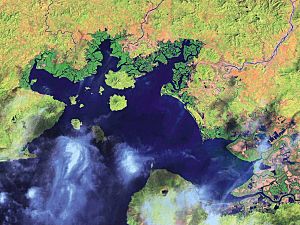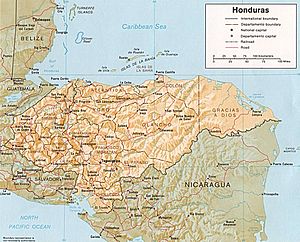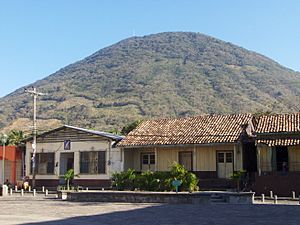Gulf of Fonseca facts for kids
The Gulf of Fonseca (which is called Golfo de Fonseca in Spanish) is a large bay that is part of the Pacific Ocean. It is located in Central America and touches the coastlines of three countries: El Salvador, Honduras, and Nicaragua.
Contents
A Look Back in Time
The Gulf of Fonseca was first seen by Europeans in 1522. A Spanish explorer named Gil González Dávila discovered it. He named the gulf after his boss, Juan Rodríguez de Fonseca, who was an archbishop.
In 1849, a person named E. G. Squier from the United States made a deal. This deal was about building a canal across Honduras. The canal would connect the Caribbean Sea to the Gulf of Fonseca.
The British commander in Central America, Frederick Chatfield, was worried. He thought the American presence might cause problems for the British area called the Mosquito Coast. So, he sent his ships to take over El Tigre Island, which is at the entrance to the Gulf. However, Squier had expected this. He had already arranged for the island to be temporarily given to the United States. Because of this, Chatfield had to leave.
All three countries around the Gulf—Honduras, El Salvador, and Nicaragua—have had long disagreements. These arguments were about who owned parts of the Gulf and its islands.
Important Court Cases
In 1917, a court called the Central American Court of Justice made a decision. This case was known as the Fonseca case. It happened because El Salvador and Nicaragua had a disagreement. Nicaragua had signed a deal called the Bryan–Chamorro Treaty. This deal gave a part of the bay to the United States for a naval base. El Salvador argued that this went against its right to share ownership of the bay. The court agreed with El Salvador, but the United States chose to ignore the decision.
Later, international problems over the Gulf were handled by the United Nations. This was part of a mission that started in 1989. For example, because the land made it hard to watch from one spot, mobile teams were used. These teams would patrol by road, helicopter, and even by boat in the Gulf.
In 1992, another court, the International Court of Justice (ICJ), made a big decision. This decision was about land, islands, and sea borders. The ICJ decided that El Salvador, Honduras, and Nicaragua should all share control of the Gulf of Fonseca. El Salvador was given the islands of Meanguera and Meanguerita. Honduras was given El Tigre Island.
The Gulf's Natural Features
The Gulf of Fonseca covers an area of about 3,200 square kilometers (about 1,235 square miles). Its coastline stretches for 261 kilometers (about 162 miles). Of this, 185 kilometers (about 115 miles) are in Honduras. Nicaragua has 40 kilometers (about 25 miles), and El Salvador has 29 kilometers (about 18 miles).
Climate and Weather
The climate in the Gulf is like other tropical and subtropical places. It has two main seasons: a rainy season and a dry season. The Gulf gets almost 80% of its yearly rainfall (1,400 to 1,600 mm) during the rainy season. This season lasts from May to November.
The dry season is from December to May. During this time, less water flows into the Gulf. This causes ocean currents to flow inward from the Pacific. The amount of salt in the river mouths (called estuaries) goes up. Sometimes, there can be a seasonal drought.
Temperatures in the Gulf usually range from 25 to 30 degrees Celsius (77 to 86 degrees Fahrenheit). March and April are the warmest months. November and December are the coolest. The air's humidity changes between 65% and 86%.
Plants and Animals
The plants in the Gulf's wetland areas are mostly mangrove trees. There are six types of mangroves found here. The red mangrove (Rhizophora mangle) is the most common. It grows in areas that are always covered by tides.
The black mangrove (Avicennia germinans) is the second most common. It is usually found near rivers where dirt settles along the shore. The white mangrove (Laguncularia racemosa) is next. Then comes botoncillo (Conocarpus erectus). These two are often found further inland and are not covered by tides as often. The type of mangrove that grows best depends on how often it floods, the water quality, and how much salt is in the water.
The tides in the Gulf go up and down by about 2.3 meters (7.5 feet) each day. When the tide is low, the muddy ground is home to crabs, conch, and other creatures. When the tide is high, the mangrove forests become a feeding place and home for fish and shrimp. The roots of the mangroves offer a safe place from bigger predators.
There are also several volcanoes in and around the Gulf.
See also
 In Spanish: Golfo de Fonseca para niños
In Spanish: Golfo de Fonseca para niños




